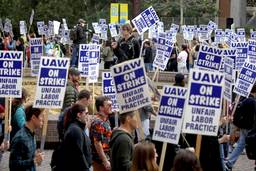How Unions Are Fighting to Protect Abortion Rights
From collective bargaining to creative use of release time, unions can defend the reproductive freedom of their members. Here’s how some are doing it.
C.M. Lewis

On May 2, Politico issued a bombshell report based upon a leaked draft of a majority opinion by the Supreme Court fully overturning Planned Parenthood v. Casey and Roe v. Wade—a devastating repeal of nearly 50 years of federal protection for abortion rights. The decision is expected this month, but the unprecedented revelation triggered a political earthquake and widespread alarm.
Organized labor began to issue a slow wave of statements opposing the draft opinion and pledging support for abortion and reproductive rights. AFL-CIO President Liz Shuler, the first woman to head the national labor federation, issued a statement on May 3 condemning the draft decision — a stark reversal of the AFL-CIO’s historic reticence on abortion rights. Even the International Union of Painters and Allied Trades, a member of the typically more conservative Building Trade Department, issued a statement defending “women’s fundamental right to healthcare and bodily autonomy.”
The response reflects a significant change in organized labor. Some unions, seeing the threat of Dobbs v. Jackson Women’s Health Organization, even intervened in the case early: AFSCME and SEIU signed amicus briefs supporting reproductive rights. But responses since the Politico report reveal some trepidation in the movement, with most unions making general statements in support of reproductive rights while a small number — such as the NewsGuild-CWA and Vox Media Union — have pledged more concrete action to collectively bargain protections for abortion.
According to Dr. Rebecca Givan, a professor of labor and industrial relations at Rutgers University, there’s a lot unions can do to protect abortion access. “I think that unions will try to protect access of their members through making sure contracts and health insurance coverage combined are sufficient to support anyone who needs access to abortion care.”
Unions like the NewsGuild-CWA are intent on doing exactly that. Jon Schleuss, the President of the union, described being stunned by the leak, but quickly realizing that action needed to be taken. “It was really important to immediately bring in members and other leaders in the Guild to start discussing how we collectively felt,” said Schleuss. “That way we could channel our anger and outrage into productive collective action.”
For the NewsGuild-CWA, strengthening existing collective bargaining agreements — like Givan suggests — is a natural starting point for discussing how unions can protect abortion access. “We have a lot of members in states that have a lot of these trigger laws,” Schleuss explained. “There’s three different newsrooms in Texas, several in Missouri, and we’ve got national members who are spread across the country. So how do we actually affirm abortion access inside our contracts?”
According to Jaya Saxena, a senior writer at Eater and activist with Vox Media Union, workers are facing similar challenges protecting a dispersed membership spread across states with trigger laws. “We’re an extremely remote company,” said Saxena. “Vox Media has headquarters in New York and D.C., but there are a lot of people who work from home and work in different states.”
Vox workers had anticipated an attack on abortion rights, and had already made proposals strengthening abortion access for their members. In addition to ensuring that health insurance covers the cost of abortions, they’re looking at the broader question of access, such as assistance and financial support to employees who have to travel from states where abortion care isn’t available. With the leaked ruling, workers are looking ahead at future attacks, like on same sex marriage. But, Saxena says, “It’s so hard to anticipate what might happen in the future and try to write a contract or proposed wording that would account for these awful hypotheticals.”
Securing a strong contract may prove to be a fight. The Vox Media Union has issued notice of its intent to strike if a new deal isn’t reached before June 13, when the current contract expires, though the strike does not appear to hinge on the reproductive rights measures. An impressive 95% of workers have signed strike pledges.
But fighting to strengthen collective bargaining agreements is only a starting point, according to Givan. She’s concerned about whether organized labor will organize to fight back, and whether labor will consider unorthodox approaches — like using union release time to do the abortion access work of providing transportation and childcare, similar to how many unions use release time for elections.
A key battleground, however, may prove far bigger than individual collective bargaining agreements: union healthcare trusts. Trusts, sometimes called “Taft-Hartley Trusts,” are nonprofit entities administering the funds for health insurance and healthcare plans — usually covering multiple employers with employees represented by the same union — with trustees split between participating unions and management. According to Form 5500s, a standard annual report on benefit performance and operations filed with the Department of Labor, just 10 of the largest union healthcare trusts cover approximately 581,000 plan participants, with nearly $25 billion dollars in assets. Millions of Americans are covered by union healthcare trusts, some of which — like the 1199SEIU National Benefit Fund, which covers approximately 154,000 plan participants—already guarantee abortion coverage. However, not all do: The United Food and Commercial Workers and Food Employers Benefit Fund explicitly excludes medications that induce abortion from prescription drug coverage, and the Teamsters Health and Welfare Fund of Philadelphia and Vicinity excludes elective abortion.
How far unions go to defend abortion access, either at the bargaining table or elsewhere, remains to be seen. Givan thinks that the muted response from some segments of organized labor demonstrates profound anxiety about the November midterm elections.
“I think organized labor feels cornered by so-called culture war issues right now,” said Givan. “Unions perceive, rightly or wrongly, that swing state voters line up with union leadership on economic issues, but there are questions about how they do when [unions] go beyond those.” Concern about pushing beyond so-called “bread and butter” issues may shape organized labor’s response once a final ruling is issued, according to Givan: “I think those questions are really at the forefront of everyone’s mind thinking about November, because the potential consequences of a bad election outcome in November are obviously significant.”
Despite the reticence of some union leaders, recent polling has shown that the public overwhelmingly supports abortion rights.
But, at least for some union leaders, the question of whether workers should demand abortion access or stay out of the “culture wars” has a clear answer. Schleuss underscores that fighting for abortion access isn’t a new fight for the NewsGuild-CWA, which first took a stance in favor of abortion rights after a contentious convention debate in 1981. He intends to continue that advocacy, especially at the bargaining table. “Abortion access is a healthcare access issue, which is a labor issue,” he says. “And we have a duty to protect the most vulnerable people in America.”
C.M. Lewis is an editor of Strikewave and a union activist in Pennsylvania. Follow him on Twitter: @thehousered







